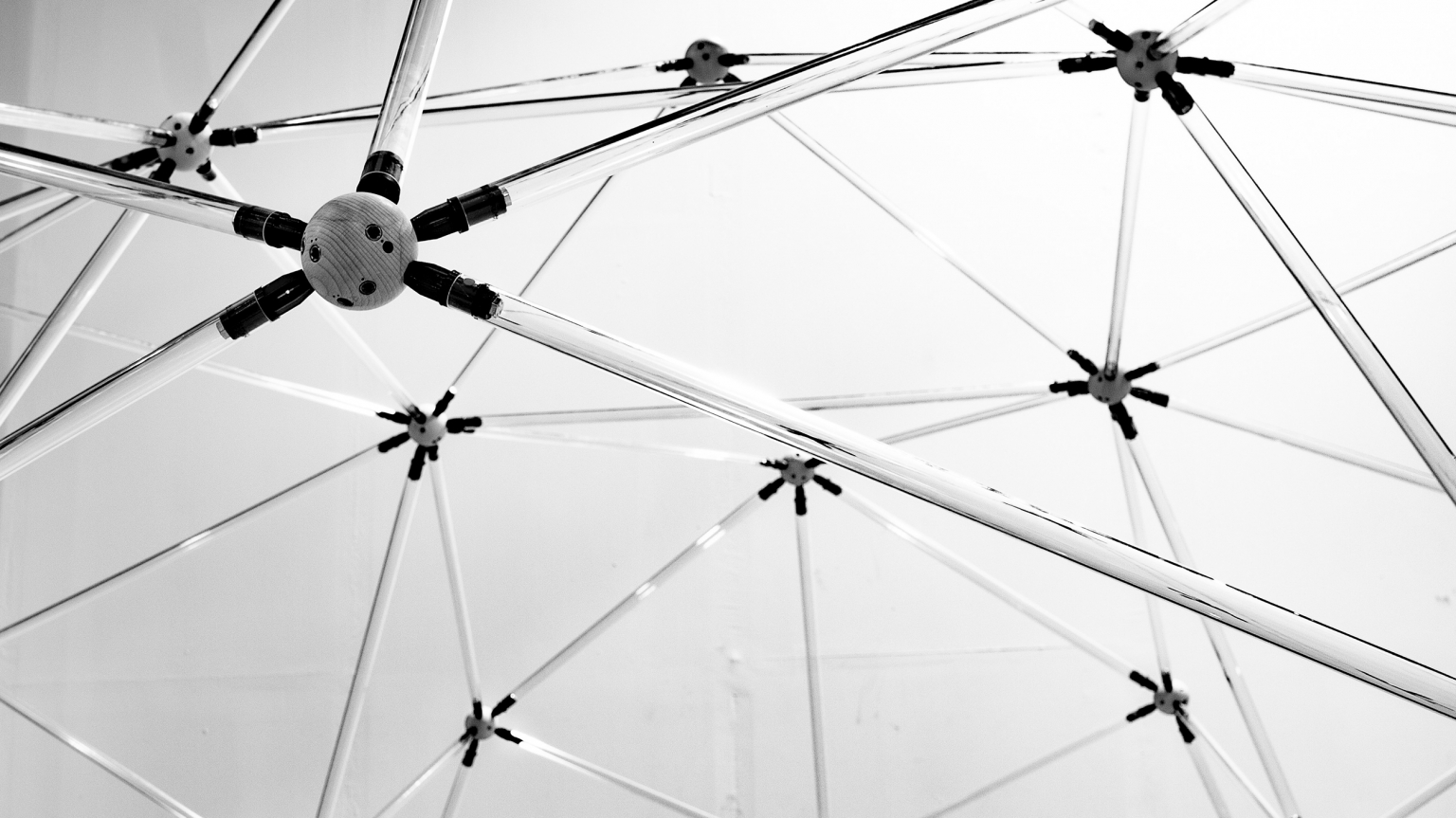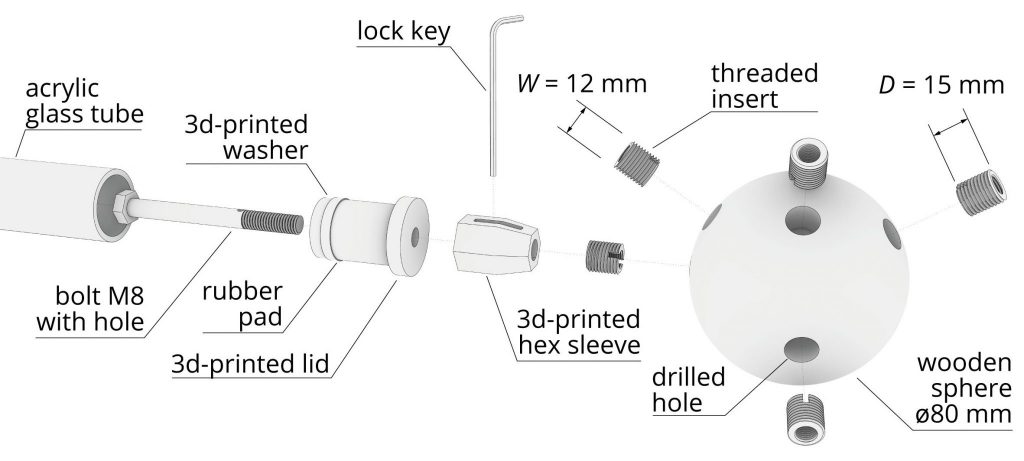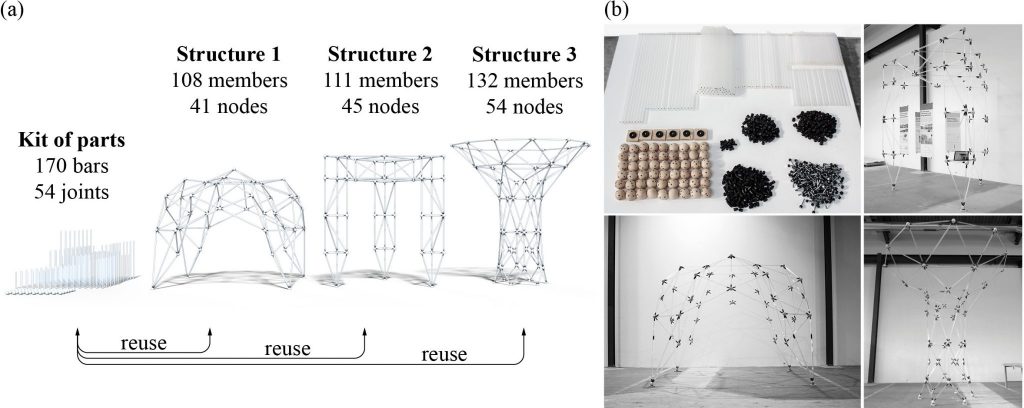multi-purpose kits of parts
Structures today are designed for a single life cycle. When they become obsolete, their components are lost and all adverse environmental impacts related to their existence becomes meaningless. What if structural components were designed not for one application but for a series of applications? What if they could be reassembled to form extremely diverse geometries and topologies, without large oversizing?

1-to-3 pavilion, smart living lab, 2019
Please note that the publication lists from Infoscience integrated into the EPFL website, lab or people pages are frozen following the launch of the new version of platform. The owners of these pages are invited to recreate their publication list from Infoscience. For any assistance, please consult the Infoscience help or contact support.
Synthesis of Kit-of-parts Structures for Reuse
This paper shows a computational workflow to design a kit of parts consisting of linear bars and spherical joints that can be employed to assemble, take apart, and rebuild diverse reticular structures, e.g. gridshells and space frames. Being able to reuse bars and joints among different structures designed with this method reduces the material demand compared to one-off construction. The input of the method is a set of different reticular structures intended to be built from a common kit of parts. In a first step, the structure geometries are optimised such that the structures share groups of members with identical lengths to allow the placement of same bars in all structures. In a second step, the kit-of-parts joints are optimised to allow their reuse in different structures as well. This is achieved by merging the specific connection patterns of nodes from different structures into one joint. The potential of the proposed method is demonstrated via its application to two case studies: 1) the design of three temporary space frame roofs, and 2) the realisation of three pavilion-scale prototypes serving as a proof of concept. The latter case study also shows the robotic fabrication of the bespoke joints.
2021-04-29. Advances in Architectural Geometry 2020, Paris, France, April 26-29, 2021.
Please note that the publication lists from Infoscience integrated into the EPFL website, lab or people pages are frozen following the launch of the new version of platform. The owners of these pages are invited to recreate their publication list from Infoscience. For any assistance, please consult the Infoscience help or contact support.
Design and fabrication of a reusable kit of parts for diverse structures
Reusing structural components for multiple service cycles has potential to lower building structures environmental impact because it reduces material resource use, energy consumption, and waste production. One strategy to reuse structural components is to design structures that can be assembled, taken apart, and reassembled in new configurations. This paper presents a new computational workflow to design a bespoke kit of parts that can be employed to build structures of diverse typologies and that are not restricted to repetitive modular arrangements. Key to this method is the optimization of structural members and joints (i.e. the kit of parts) that fit multiple geometries and different structural requirements. The proposed method includes form finding and digital fabrication and it applies to the design of trusses, gridshells, and space frames. This method has been successfully applied to build three pavilion-scale prototypes from only half the number of parts compared to one-off construction.
Automation in Construction. 2021-03-04. Vol. 125, p. 103614. DOI : 10.1016/j.autcon.2021.103614.
Please note that the publication lists from Infoscience integrated into the EPFL website, lab or people pages are frozen following the launch of the new version of platform. The owners of these pages are invited to recreate their publication list from Infoscience. For any assistance, please consult the Infoscience help or contact support.
Form follows availability – Designing structures through reuse
This work proposes a new direction in structural design: the synthesis of structures through the reuse of elements. Reusing structural elements reduces the environmental impacts of building structures because it avoids sourcing new material, it reduces waste and it requires little energy. Designing structures from reused elements is unlike conventional structural design because stock element availability is a design input. In other words, structures must be designed subject to availability of given element characteristics such as length and cross-section type, which have a major influence on the optimal structure layout and form. In this new paradigm structural form follows availability. In this work new computational methods for the synthesis of reticular structures through reuse are formulated to address two scenarios: a) reuse of reclaimed elements from a given stock, and b) design of an element stock which is used as a kit of parts to build diverse structures. Case studies are presented to demonstrate the potential of the proposed methods. It is shown that structures produced by these methods have a significantly lower environmental impact than minimum weight structures made of new elements.
Journal of the International Association for Shell and Spatial Structures. 2019. Vol. 60, num. 4, p. 257-265. DOI : 10.20898/j.iass.2019.202.033.

Other publications:
- Exploration of spatial structures made from reused elements and the design of optimal kits-of-parts
ICSA conference 2019 (detailed record)